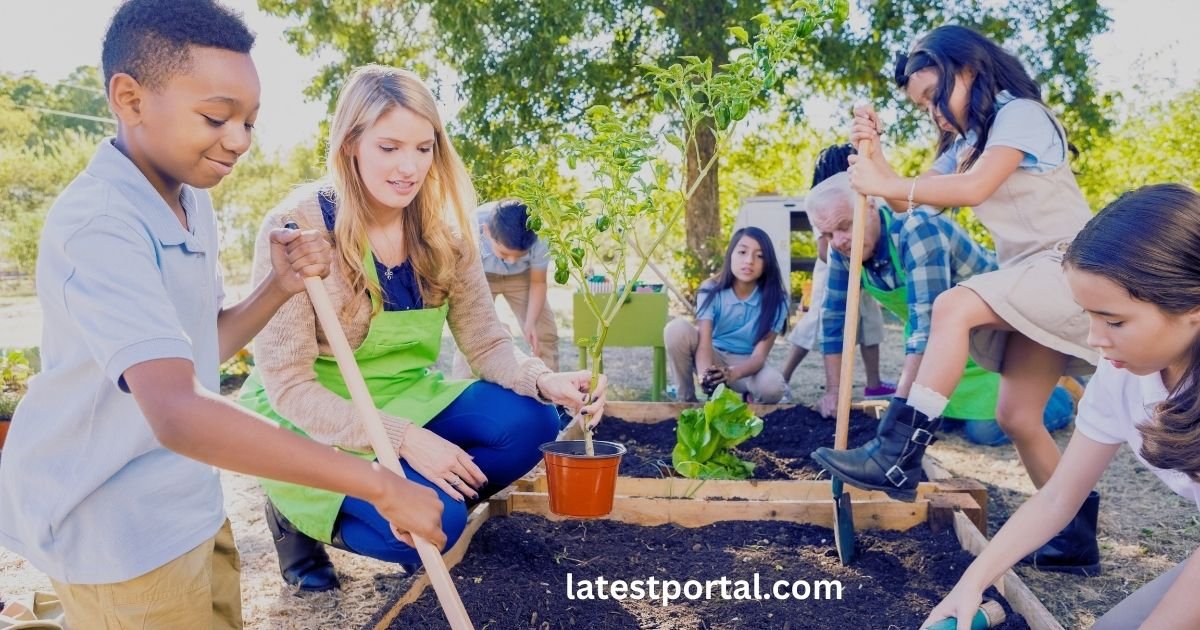Measure the success of a school garden by evaluating student engagement, academic improvement, and the garden’s impact on the community. Assess sustainability practices and crop yield too.
A school garden is an educational tool, promoting hands-on learning and environmental stewardship. Students gain valuable science, math, and nutrition through direct involvement in garden activities. The garden also fosters a sense of responsibility and teamwork among students.
Teachers can integrate the garden into various subjects, making learning more interactive and engaging. Community involvement enhances the garden’s value, providing support and resources. Successful school gardens often show increased academic performance and healthier eating habits among students. By focusing on these key areas. Schools can effectively measure the garden’s success and ensure its long-term benefits.

Credit: www.slideshare.net
Student Engagement
A school garden can be a fantastic tool for learning and growth. But how do you measure its success? One crucial aspect is student engagement. Engaged students are more likely to gain the benefits of the school garden. Here are some ways to measure student engagement.
Participation Rates
Tracking participation rates is a simple way to measure engagement. Create a log to record the number of students involved in garden activities. You can break it down by:
- Grade Level.
- Classroom.
- Specific garden tasks.
Use a table to keep track:
| Grade Level | Number of Participants | Garden Tasks |
|---|---|---|
| Grade 1 | 20 | Planting, Watering |
| Grade 2 | 25 | Weeding, Harvesting |
Student Feedback
Collecting student feedback helps understand their experience. Use surveys or suggestion boxes to gather input. Ask questions like:
- What did you enjoy about the garden?
- What did you learn?
- What can be improved?
Analyze the feedback to identify trends. Positive feedback indicates high engagement. Use this data to make necessary adjustments to enhance the garden program.
By keeping track of participation rates and gathering student feedback, you can gauge how well your school garden engages students. This information is vital for making improvements and ensuring the garden remains a valuable educational tool.
Academic Impact
A school garden can greatly affect students’ academic lives. It can help them learn better and improve their grades. Let’s explore how a garden helps in academic success.
Improvement In Science Scores
A school garden offers hands-on learning. Students can see science in action. They learn about plants, insects, and weather. This practical learning helps them remember better.
Teachers can connect garden activities with science lessons. This can boost students’ understanding and test scores. A study showed schools with gardens saw a 15% rise in science scores.
| School | Before Garden | After Garden |
|---|---|---|
| School A | 65% | 80% |
| School B | 70% | 85% |
Enhanced Learning Experiences
The garden is a living classroom. Kids can touch, see, and smell what they learn. This makes lessons more exciting. It keeps them engaged and curious.
Students can work in groups in the garden. They learn teamwork and communication. They also develop problem-solving skills while planting or weeding.
- Hands-on activities
- Group projects
- Critical thinking
These experiences make learning fun and effective. They also help students gain life skills.
Nutritional Benefits
School gardens provide many nutritional benefits for children. They encourage kids to eat more vegetables and develop healthy eating habits. Understanding these benefits helps measure the success of your school garden.
Increased Vegetable Consumption
Kids in schools with gardens often eat more vegetables. Fresh vegetables from the garden taste better. They are more appealing to children. Growing their own food makes kids excited to try new veggies.
Teachers and parents notice these changes. They see kids choosing vegetables more often. This increase in vegetable consumption is a key success marker for school gardens.
| Vegetable | Consumption Increase |
|---|---|
| Carrots | 30% |
| Spinach | 25% |
| Tomatoes | 20% |
Healthy Eating Habits
School gardens help kids form healthy eating habits. They learn to love fruits and vegetables. This love can last a lifetime.
Gardening teaches kids where their food comes from. They understand the importance of fresh, organic produce. This knowledge leads to better food choices.
- Kids learn to prefer fresh produce.
- They make healthier food choices.
- They influence their families to eat better.
These habits can reduce the risk of chronic diseases. Healthy eating starts early, and school gardens play a big role.
Environmental Awareness
Measuring the success of a school garden involves many factors. One crucial aspect is environmental awareness. Understanding nature and sustainability is vital for young minds. A school garden can be a powerful tool in fostering this awareness.
Knowledge Of Sustainable Practices
Students gain firsthand experience with sustainable practices in a school garden. They learn about composting, recycling, and conserving water.
- Composting: Turning food scraps into nutrient-rich soil.
- Recycling: Separating waste to reduce landfill usage.
- Water Conservation: Using rain barrels and drip irrigation.
Engaging in these practices helps children understand the importance of sustainability. They see the direct impact of their actions on the environment.
Attitudes Toward Nature
Being in a garden can change students’ attitudes toward nature. It fosters a sense of responsibility and appreciation for the environment. Here are some key changes in attitudes:
- Increased empathy for living organisms.
- Greater interest in protecting natural resources.
- Heightened awareness of ecological balance.
These shifts in attitude can be measured through surveys and observation. Teachers can note changes in behaviour and interest levels.
In summary, a school garden enhances environmental awareness. It instils sustainable practices and positive attitudes toward nature.
Community Involvement
Community involvement is key to a successful school garden. It fosters a sense of ownership and shared responsibility. Engaging parents, local businesses, and volunteers can provide valuable resources and support.
Parental Participation
Parents can play a vital role in a school garden. They can volunteer their time to help with planting, weeding, and harvesting. Parent volunteers can also assist with garden events and educational activities. Engaging parents can be done through:
- Workshops on gardening techniques
- Family garden days for joint activities
- Newsletters to keep parents informed
Involving parents makes them feel connected to the school. Their participation often leads to a more vibrant and productive garden.
Local Partnerships
Local partnerships can greatly enhance a school garden. Businesses and community organizations can offer financial support, materials, and expertise.
| Partner | Possible Contribution |
|---|---|
| Local Nurseries | Donate plants and gardening supplies |
| Restaurants | Buy produce grown in the garden |
| Community Centers | Provide volunteers and educational programs |
Financial Metrics
Measuring the success of a school garden involves various metrics. One of the most significant aspects is financial metrics. These metrics help track the economic benefits and sustainability of the garden.
Cost Savings On Produce
One of the direct financial benefits of a school garden is the cost savings on produce. Growing vegetables and fruits on-site can significantly reduce the school’s grocery bill. Schools can use fresh produce in their cafeterias, leading to lower food costs.
Tracking cost savings is simple. Compare the amount spent on produce before and after the garden’s implementation. Create a table to keep a record:
| Month | Produce Cost Without Garden | Produce Cost With Garden | Cost Savings |
|---|---|---|---|
| January | $500 | $300 | $200 |
| February | $450 | $275 | $175 |
Funding And Grants
Many schools receive funding and grants to support their garden projects. These financial aids can come from local governments, non-profits, or corporate sponsors. Tracking these funds is essential to measure the garden’s financial success.
Keep a detailed record of:
- The amount of each grant or funding received.
- The source of the funds.
- How the funds are allocated.
This information can be organized in a table for clarity:
| Source | Amount | Use |
|---|---|---|
| Local Government | $1,000 | Tools and Supplies |
| Non-Profit Organization | $500 | Seeds and Plants |
By keeping track of these financial metrics, schools can ensure the garden remains a sustainable and beneficial project.
Long-term Sustainability
Ensuring the long-term sustainability of a school garden is crucial. It’s not just about planting seeds but also about making sure the garden thrives for years. This involves creating effective maintenance plans and ensuring program longevity.
Maintenance Plans
A well-thought-out maintenance plan is essential. It helps keep the garden healthy and productive. Here are some key elements to include:
- Regular Watering: Set a schedule for watering the plants. Use timers if possible.
- Weeding: Assign students or volunteers to remove weeds weekly.
- Soil Health: Test the soil annually. Add nutrients as needed.
- Pest Control: Monitor for pests. Use organic methods to manage them.
Create a calendar to track these tasks. Share it with everyone involved. This ensures no task is overlooked.
Program Longevity
To achieve program longevity, consider the following strategies:
- Funding: Secure continuous funding through grants or community donations.
- Community Involvement: Engage parents and local businesses. They can offer support and resources.
- Curriculum Integration: Incorporate the garden into school lessons. This ensures its use and relevance.
- Student Leadership: Encourage older students to mentor younger ones. This creates a cycle of knowledge and care.
These steps ensure the garden remains a vital part of the school community. They foster a sense of ownership among students and staff.
| Task | Frequency | Responsible |
|---|---|---|
| Watering | Daily | Students |
| Weeding | Weekly | Volunteers |
| Soil Testing | Annually | Science Teacher |
| Pest Control | Monthly | Garden Coordinator |

Credit: www.pennington.com

Credit: community.kidsgardening.org
Frequently Asked Questions
How To Measure A Garden?
Measure the garden’s length and width using a measuring tape. Multiply the two numbers to get the area. Use square feet or meters.
How Do You Sustain A School Garden?
Regularly water and weed the garden. Engage students and teachers in maintenance activities. Use organic fertilizers and compost. Rotate crops seasonally. Secure funding or donations for supplies.
How Can A School Garden Be Beneficial?
A school garden enhances hands-on learning, promotes healthy eating, and teaches students about nature. It fosters teamwork and responsibility.
What Are The Objectives Of the Gardening Class?
Gardening class aims to teach plant care, soil management, and sustainable practices. Students learn to grow vegetables, flowers, and herbs. The class also fosters environmental awareness and promotes relaxation.
You can read also:
- What Do You Believe is the Purpose of Education: Unveiling Truths
- What to Do If School is Stressing You Out: Proven Strategies
- When is the Best Time to Go School Clothes Shopping: Top Tips
- How Often Should RE Be Taught in Primary Schools?
Conclusion
Measuring the success of a school garden involves observing various factors. Track student engagement, plant health, and harvest yields. Collect feedback from teachers and students. Use these metrics to refine and improve the garden. A thriving school garden can enhance education and foster a love for nature.
- Universal Medical College Hospital All Doctor List 2025

- AMZ Hospital Badda All Doctor List , Appointment, Fee 2025

- BRB Hospital Dhaka All Doctor List, Appointment & Cost

- এভারকেয়ার হাসপাতাল ঢাকা সকল ডাক্তারদের তালিকা ২০২৫

- Evercare Hospital All Doctor List 2025

- India All State Medical Colleges List 2024

- Top 20 Ranking MEdical Colleges in India 2024

- What is the Difference between Common Application and University Application?

- How Much are University Tuition Fees in the UK: 2024 Cost Guide

- What to Do If Your University Application is Rejected: Complete Guidelines

- Why It is Important in the University Application Process: Key Insights

- Difference between State University And Private University: Key Insights


1 thought on “How to Measure the Success of a School Garden: Key Metrics Explained”